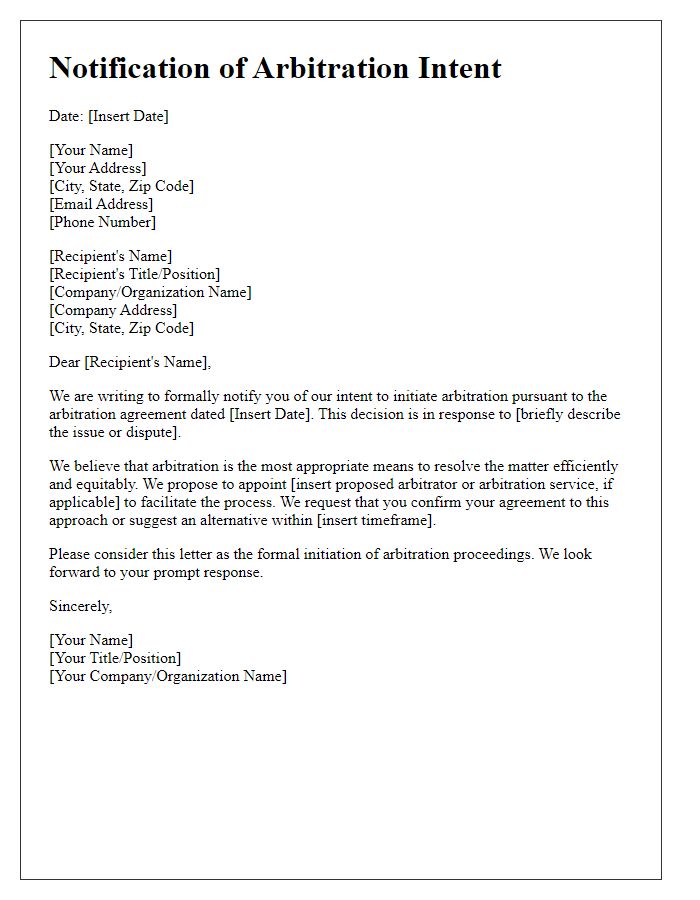Are you ready to take the first step towards resolving your dispute through arbitration? Initiating an arbitration agreement can seem complex, but it's a straightforward process that offers an effective alternative to traditional litigation. By entering into an arbitration agreement, both parties can engage in a more efficient and collaborative approach to mediation. Explore this article to discover key insights and helpful templates to guide you through this process!

Parties involved names and contact information
An arbitration agreement initiation requires clear identification of the parties involved, including their full legal names, contact details, and any relevant affiliations. For instance, one party may be "XYZ Corporation, a Delaware registered entity, with a principal place of business at 123 Business Ave, Wilmington, DE 19801, contact number (302) 555-1234." The opposing party can be "John Smith, residing at 456 Residential Rd, Springfield, IL 62701, contact number (217) 555-5678." Each party should also provide an email address for effective communication. Additionally, details regarding the nature of the dispute, the specific allegations, and preferred arbitration rules may be included to facilitate prompt action.
Clear statement of arbitration intent
Initiating an arbitration agreement requires a clear expression of intent to resolve disputes through arbitration rather than litigation. This formal declaration typically specifies the dispute, the parties involved, and the chosen arbitration rules, such as those from the American Arbitration Association (AAA) or the International Chamber of Commerce (ICC). Including important details, such as the arbitration location (for example, New York City) and the timeline for initiating proceedings, enhances clarity. Additionally, outlining the scope of arbitration, including potential claims and remedies sought, helps to establish a mutual understanding of expectations. Terms may also specify the arbitrator selection process, emphasizing impartiality and qualifications. Ensure both parties sign the arbitration agreement to affirm commitment to this resolution method.
Specific disputes or issues to address
Arbitration agreements establish a framework for resolving specific disputes outside of traditional court systems. Common issues addressed typically include contractual disagreements, such as unfinished projects or unpaid invoices, often involving construction and service agreements. Asset disputes can arise over property division or business valuations, especially in cases like divorce settlements or partnership dissolutions. Additionally, employment-related conflicts, including wrongful termination claims or wage disputes, frequently prompt the need for arbitration. Intellectual property infringements, such as patent disputes in technology sectors, are also common scenarios. These agreements often specify the arbitrator's qualifications and the chosen arbitration institution, which can greatly influence the outcome and efficiency of the resolution process.
Governing rules and laws
The initiation of arbitration agreements involves detailed specifications regarding governing rules and applicable laws to ensure fairness and enforceability. Institutions like the American Arbitration Association (AAA) or the International Chamber of Commerce (ICC) often provide frameworks for resolving disputes. Such frameworks may stipulate the arbitration procedures, qualifications of arbitrators, and the allocation of costs. Additionally, relevant laws such as the Federal Arbitration Act (FAA) in the United States or similar statutes in other jurisdictions define the scope and limitations of the arbitration process. Specific provisions regarding the venue for arbitration, typically chosen for its neutrality, are crucial to the agreement. These details help to establish a comprehensive understanding between parties and facilitate a smoother resolution process.
Selection and appointment of arbitrator details
In arbitration agreements, the selection and appointment of arbitrators is crucial for resolving disputes effectively. Typically, the agreement specifies the number of arbitrators, often one or three, depending on the complexity of the case. The designated institution, such as the International Chamber of Commerce (ICC) or American Arbitration Association (AAA), may provide guidelines for selecting arbitrators. Commonly, parties can mutually agree on the arbitrator's qualifications, including expertise in specific industries or legal fields relevant to the dispute. Deadlines for nominations, often ranging from 30 to 60 days after the initiation of arbitration, are often established to ensure efficiency. In instances of disagreement, procedures for appointing arbitrators, such as involving a court or the arbitration institution, are typically outlined.













Comments